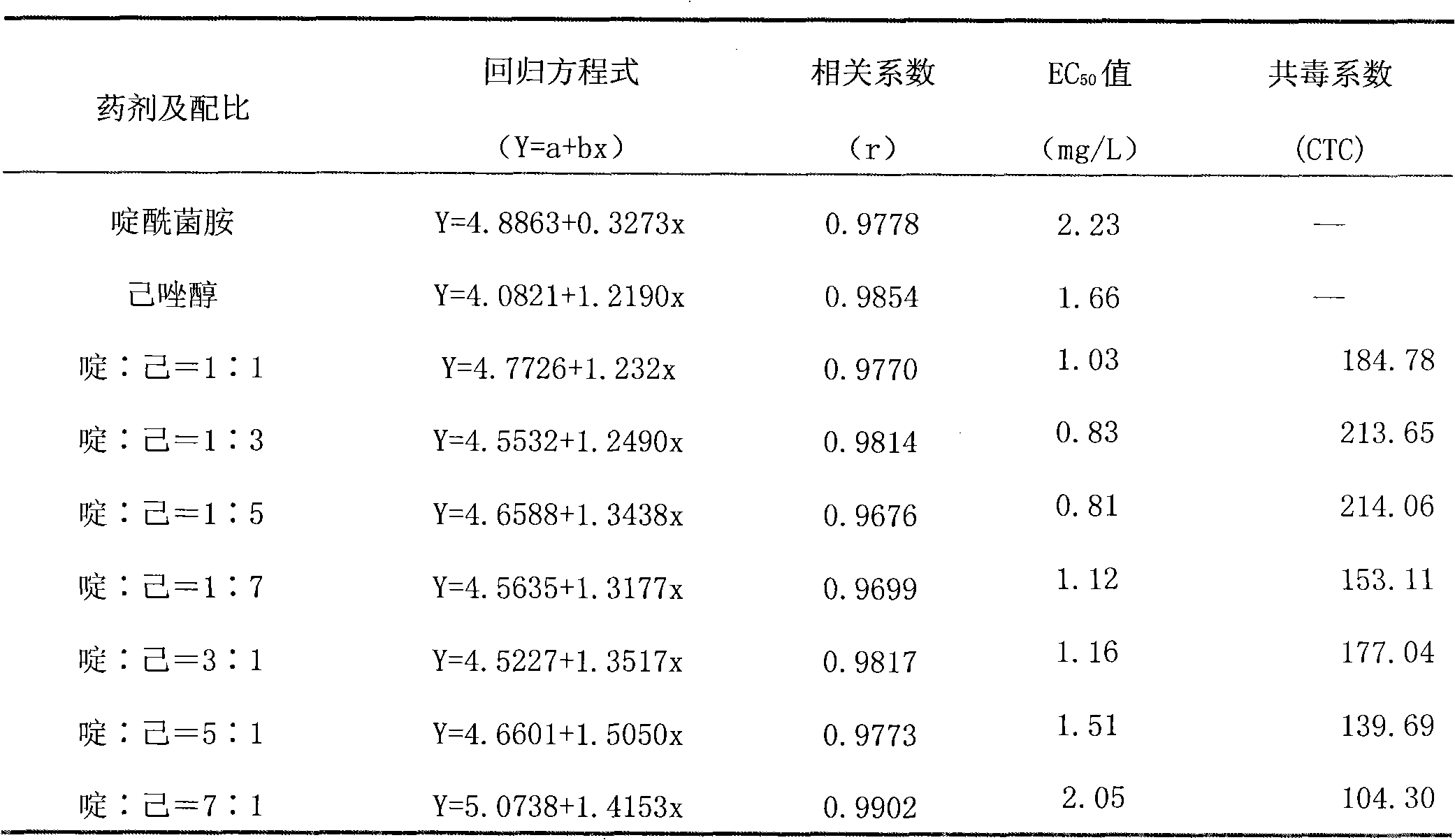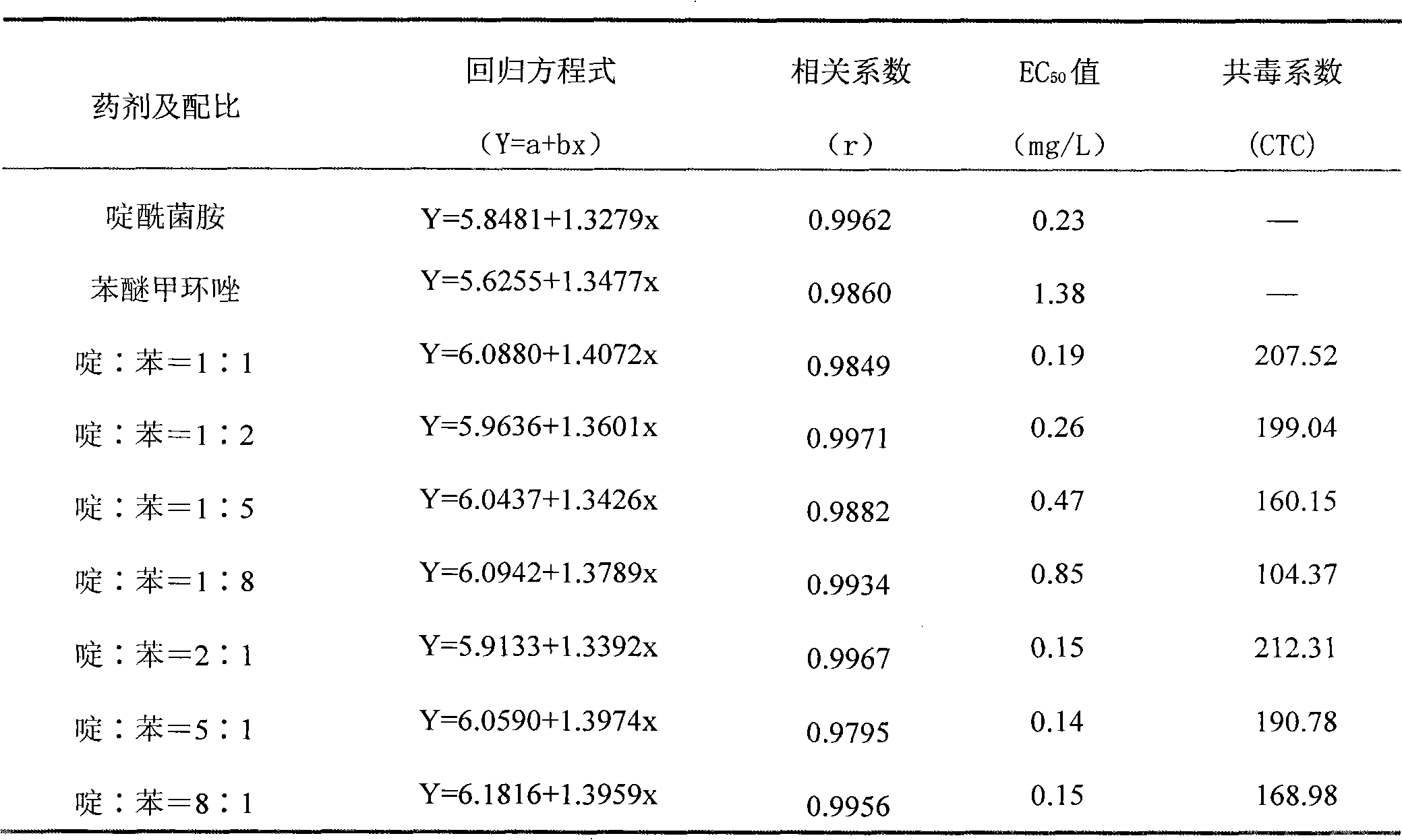Bacteriocidal composition containing Boscalid and triazole bactericide
A technology of boscalid and a composition, applied in the field of bactericidal compositions, can solve the problems of no application and high cost, and achieve the effects of improving bactericidal effect, overcoming resistance, and improving synergism.
- Summary
- Abstract
- Description
- Claims
- Application Information
AI Technical Summary
Problems solved by technology
Method used
Image
Examples
example 1
[0023] Physical measurement example 1: Toxicity determination of the combination of boscalid and hexaconazole to rice sheath blight
[0024] 1. Test object: rice sheath blight [Latin name: Thanatephorus cucumeris (Frank) Donk.]
[0025] 2. Test method: refer to "Pesticide Bioassay Test Guidelines NY / T 1156.5-2006", and use the drug-containing medium method.
[0026] 3. Statistical analysis of data: use SAS6.12 statistical software for analysis. Calculate the mycelia growth inhibition rate (%) according to the test data, and obtain the virulence regression equation, correlation coefficient (r), EC 50 and co-toxicity coefficient.
[0027] 4. Evaluation method: Refer to the "Pesticide Bioassay Test Guidelines NY / T 1156.5-2006", and evaluate the synergistic effect of the drug mixture according to the co-toxicity coefficient method (CTC) of Sun & Johnson (1960), that is, CTC ≤ 80 is an antagonistic effect, 80<CTC<120 is an additive effect, and CTC≥120 is a synergistic effect.
...
example 2
[0033] Physical Test Example 2: Determination of Toxicity of Boscalid and Difenoconazole Compound to Barley Leaf Rust
[0034] 1. Test object: barley leaf rust [Latin scientific name: Puccinia hordei Otth.]
[0035] 2. Test method: refer to the "Pesticide Bioassay Test Guidelines NY / T 1156.15-2008", and use the drug-containing medium method.
[0036] 3. Statistical analysis of data: use SAS6.12 statistical software for analysis. Calculate the mycelia growth inhibition rate (%) according to the test data, and obtain the virulence regression equation, correlation coefficient (r), EC 50 and co-toxicity coefficient.
[0037] 4. Evaluation method: Refer to the "Pesticide Bioassay Test Guidelines NY / T 1156.15-2008", according to Sun & Johnson (1960) co-toxicity coefficient method (CTC) to evaluate the synergistic effect of drug mixing, that is, CTC ≤ 80 is an antagonistic effect, 80
[0038] 5. Results and analy...
example 3
[0043] Physical measurement example 3: Toxicity determination of the combination of boscalid and flutriazole to triticale leaf rust
[0044] 1. Test object: Triticale leaf rust [Latin scientific name: ccinia recondita=P.Recondita Roberge ex Desmaz.f.tritici]
[0045] 2. Test method: refer to the "Pesticide Bioassay Test Guidelines NY / T 1156.15-2008", and use the drug-containing medium method.
[0046] 3. Statistical analysis of data: use SAS6.12 statistical software for analysis. Calculate the mycelia growth inhibition rate (%) according to the test data, and obtain the virulence regression equation, correlation coefficient (r), EC 50 and co-toxicity coefficient.
[0047] 4. Evaluation method: Refer to the "Pesticide Bioassay Test Guidelines NY / T 1156.15-2008", according to Sun & Johnson (1960) co-toxicity coefficient method (CTC) to evaluate the synergistic effect of drug mixing, that is, CTC ≤ 80 is an antagonistic effect, 80
PUM
 Login to View More
Login to View More Abstract
Description
Claims
Application Information
 Login to View More
Login to View More - Generate Ideas
- Intellectual Property
- Life Sciences
- Materials
- Tech Scout
- Unparalleled Data Quality
- Higher Quality Content
- 60% Fewer Hallucinations
Browse by: Latest US Patents, China's latest patents, Technical Efficacy Thesaurus, Application Domain, Technology Topic, Popular Technical Reports.
© 2025 PatSnap. All rights reserved.Legal|Privacy policy|Modern Slavery Act Transparency Statement|Sitemap|About US| Contact US: help@patsnap.com



